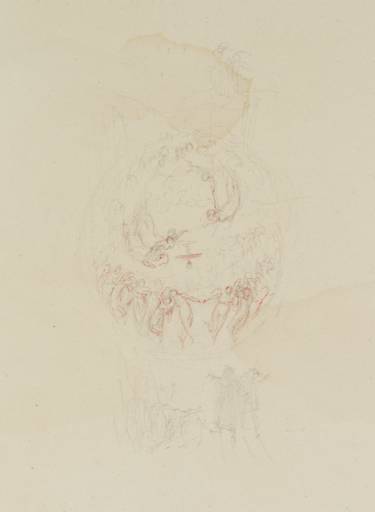This sketch belongs to a large group of preliminary studies which relate to Turner’s vignette illustrations for John Macrone’s 1839 edition of Thomas Moore’s
The Epicurean, a Tale: and Alciphron, a Poem. The study shares the same size, palette, and style as nine other works in this group, suggesting that Turner produced them all at around the same time (see Tate
D27630; Turner Bequest CCLXXX 113).
Jan Piggott has identified the subject as an experimental study for Moore’s fantastical prose tale
The Epicurean.
1 The sketch is related to the author’s description of a heavenly vision evoked by the Priest of Memphis whom the hero, Alciphron, encounters in the underworld of the Egyptian pyramids:
As he spoke these words, a burst of pure, brilliant light, like a sudden opening of heaven, broke through the valley ... Suspended, as I thought, in air, and occupying the whole of the opposite region of the valley, there appeared an immense orb of light, within which, through a haze of radiance, I could see distinctly fair groups of young female spirits, who, in silent, but harmonious movement, like that of the stars, wound slowly through a variety of fanciful evolutions; seeming, as they linked and unlinked each other’s arms, to form a living labyrinth of beauty and grace. Though their feet appeared to glide along a field of light, they also had wings, of the most brilliant hue, which, like rainbows over waterfalls, when played with by the breeze, reflected, every moment, a new variety of glory.
(The Epicurean, 1839, p.76)
Turner’s composition centres on the glowing orb and its multitude of dancing female spirits. The figures of Alciphron and the Priest appear below, gazing admiringly up toward this magnificent sight. Like many of Turner’s studies for The Epicurean, the subject was never developed into a finished illustration.

